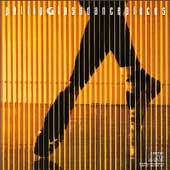

Dancepieces, released in 1987, presents music that Glass composed for two separate dance performances. The first half of the album accompanied the Twyla Tharp Dance Foundation in a show called "In the Upper Room," and the second piece accompanied choreographer Jerome Robbins' "Glasspieces." Glass writes the majority of his music for visual performances, most frequently dance and opera, and the presence of a visual twin to his music is evident throughout the selections from Dancepieces.
In discussing his technique for writing music to accompany dance, Glass has said the following, "The key factors are melody, harmony, and rhythm. It is important in dance music which requires abstract rhythmic style. A dancer likes that ... To be rhythmic, it needs to be strong and conditioned. This is more prominent in non-Western music." Within the first five seconds of each song on Dancepieces, the strength of Glass' strong rhythmic sense is evident.
Dance II from "In the Upper Room" (click here to listen to the beginning of Dance II) contains particularly strong invocations of a visual analog to the sounds created. Scattered throughout the repeated intervals of the violins that underlie the entire piece, high synthesizer chords, low sustained cello notes, and repeatedly sustained, shifted, and vibratoed violin notes evoke images of bodily extensions and movements. The piece could be interpreted as a metaphorical awakening or dawning, with the synthesizer playing the role of the sun slowly heightening in its intensity and the increasingly busy violin intervals representing the movement catalyzed by the sun. As in most Glass compositions, Dance II slowly heightens in complexity as two different sets of intervals are overlapped, and the small differences in structure create complicated intermovement once the two lines are commingled. This technique is often called "cyclic rhythm," and Glass uses this throughout his oeuvre. Like additive process, cyclic rhythm is a traditional Indian technique, and it is created by the interaction of two or more lines (or "cells" in critical jargon) of different lengths being played and repeated at the same time. Glass calls the resultant effect of this "wheels within wheels," which appropriately describes the salient complexity that stems from two seemingly simple lines of music.
More selections from Dancepieces
Page author: Kirsten Lodal